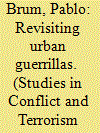| Srl | Item |
| 1 |
ID:
132181


|
|
|
|
|
| Publication |
2014.
|
| Summary/Abstract |
This article studies a singular aspect of the urban insurgency of Uruguay's MLN-Tupamaros: the tactic of armed propaganda. The Tupamaros applied the method mainly at the peak of their existence, in the years 1969-70. Afterward they opted predominantly for others, such as terrorism. By comparing the two periods, I argue that armed propaganda helped the organization to thrive, while the latter was an important cause of its demise. The conclusion suggests that armed propaganda led the Tupamaros to significant accomplishments, but also that switching tactics was a major determinant in their defeat.
|
|
|
|
|
|
|
|
|
|
|
|
|
|
|
|
| 2 |
ID:
051932


|
|
|
| 3 |
ID:
184966


|
|
|
|
|
| Summary/Abstract |
In the last two decades, urban insurgencies have become a major concern for scholars and practitioners. It is widely assumed that because half the human population now live in cities in often appalling conditions, it is inevitable that conflict has migrated to cities, not least because urban areas offer would-be insurgents the best opportunity to evade state security forces and their advanced technologies. Demography and asymmetry have been all but universally accepted in the literature as the sole causes of urban insurgency. They are certainly important. Yet, scholars have overlooked a third vital factor: the size of state forces. In the twentieth century, urban insurgencies were common. However, because states commanded very large military forces at that time, insurgents found it very difficult to operate in urban areas. By contrast, as their forces have contracted in the twenty-first century, states have been unable to dominate urban areas, as they typically did in the twentieth century. Consequently, urban enclaves have appeared inside cities from which insurgents have mounted their attacks and contested with state forces.
|
|
|
|
|
|
|
|
|
|
|
|
|
|
|
|